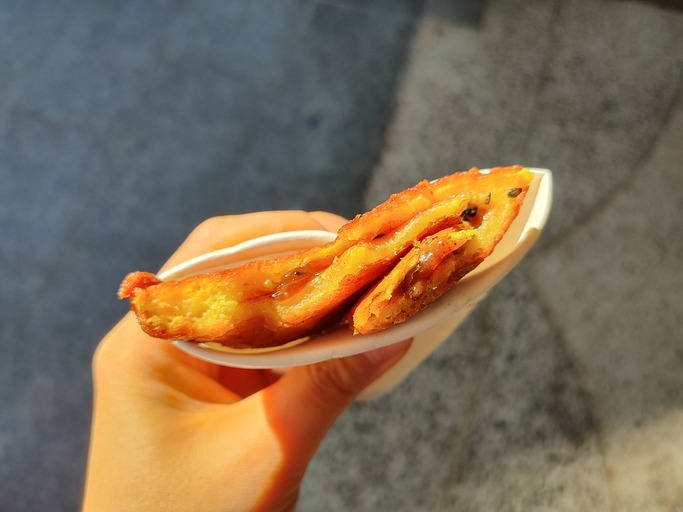Hotteok (호떡), also called Hoeddeok, is a South Korean pancake stuffed with different fillings. It’s a sweet or savory snack from Korean cuisine and is also a popular type of street food. In winter, the delicacy’s appeal comes from the warm heat it exudes after being made fresh and its sweetness that makes the cold tolerable.
How It’s Prepared
The dough used for hotteok is made from wheat flour, milk, yeast, sugar, and water. After creating the dough, it’s left to rise for a couple of hours. Handful-sized balls of the hotteok dough are filled with a sweet mixture that may contain honey, brown sugar, cinnamon, and chopped peanuts. The stuffed dough is then put on a greased griddle and pushed flat into a large circle using a special tool with a wooden handle and a stainless steel circle while it cooks.
In South Korea, there are ready-made dry hotteok mixes in plastic packages that are commercially available. Also, the hotteok mix comes with a filling of brown sugar and sesame seeds or ground peanuts.
Origins of Hotteok
Hotteok is often known to have taken its initial syllable from the onomatopoeia for the sound people make when blowing on hot food to cool, but the syllable is also said to be derived from a term symbolizing the Qing Dynasty of China. Although hotteok was presumably brought to Korea by a nomadic Chinese merchant, China isn’t considered the delicacy’s birthplace.
From 200 B.C. to A.D. 1,200-1,300, during the Han, Tang, and Song dynasties, Chinese influence spread, and it’s mainly due to the Silk Road that enabled ceramics from the Chinese region to move west, along with foodstuffs and spices from the Central Asian, Indian, and Arab regions. The snack is believed to have simply gone through the Chinese territory to Central Asia and, ultimately, the Korean Peninsula.
Over a thousand Chinese laborers arrived in Incheon every day in the spring of 1927. The Chinese who settled in the country quickly made the best food to sell to some poor customers. One of them was the “Hotteok,” which means “barbarian rice cake.” When Korea was still under Japanese rule, the Japanese named it “Jina Bread,” meaning “Chinese bread.”
Hotteok as Street Food
After arriving on the Korean peninsula, hotteok is stated to have been sold by street vendors and merchants. Soldiers from the Qing Dynasty dispatched to the Joseon Kingdom during the Imo Incident (a violent uprising in Seoul in 1882) stayed in Korea after the incident because their homeland wasn’t worth going back to. Instead, they made ends meet by selling simple snacks such as hotteok and mandu (dumplings), the former gradually evolving to accommodate the Korean palate. Fillings such as brown sugar, syrup, and honey made hotteok a hit among people with sweet tooth. From Incheon, Korea’s traditional gateway back then until today, rose forms of the dessert that made their way to Jongno-gu and Myeong-dong District, two adjacent regions in Seoul once populated by a substantial ethnic Chinese population.
True to its enduring identity and origins as street food, the snack is priced at 1,000-3,500 Korean won. Hotteok is usually sold at street kiosks called pojangmacha, though brick-and-mortar storefronts also sell it for takeout or a side dish. During the winter season, passersby often carry folded hotteok inside a paper cup, stuck on a skewer, or wrapped in an oil-proof napkin.
Different Hotteok Varieties
The most popular variant of hotteok in Korea is the pan-fried version, which debuted in 1970 with cooking oil’s introduction to the mass market; before that, the delicacy was cooked by roasting it in a furnace or fire pit. The Chinese versions of the snack include heart variants of chives, meat, and even seafood fillings.
Staying consistent throughout the history of hotteok is its classic fillings. Crush peanuts are assumed to have been incorporated into sugar as a supplement to keep the sticky liquid sugar from sagging. Variations tend to remain within a narrow category, such as hotteok with assorted nuts, seeds, or sunflower seeds. However, several creative vendors and franchises have introduced spinoffs filled with kimchi, cheese, or vegetables or made with glutinous rice. By far, the classic version stays the most popular.
Tangerine hotteok is a Jeju Island specialty, considering the multiple plantations on the island, growing Korea’s best variant of the fruit. Seed hotteok originated from the Nampo-dong neighborhood in Busan and later spread to the Haeundae and Seomyeon regions, two of Busan’s major tourist destinations. South Korea‘s 2nd city is thus personally connected with the emergence of seed hotteok, and some citizens even consider it ethnic or folk food from the southern coastal city.
Other popular versions of the snack include Namdaemun Gate hotteok, Samcheong-dong hotteok, named after the Seoul neighborhood, and variations served in the provincial cities of Cheongju, Chungcheongbuk-do Province and Gunsan, Jeollabuk-do Province.
Although many favor the traditional peanut and cinnamon filling of hotteok, many versions have been developed since the early 21st century, like pizza hotteok, green tea hotteok, corn hotteok, pink bokbunja hotteok, and more.
Nutritional Value
Hotteok, typically eaten in winter, has high sugar content. A single hotteok may contain as much as 230 calories.
